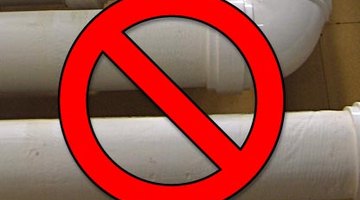Types of PVC Pipe Used for Dryer Vents
Polyvinyl chloride (PVC) pipe is strong, durable and easy to work with, and it is commonly used in home plumbing systems. These qualities may make PVC pipe seem like a good choice for venting a clothes dryer, but the opposite is actually true. For a variety of reasons, PVC pipe is not recommended for use in dryer vents, and it can actually be ineffective and dangerous.
PVC Pipe Basics

PVC pipe was first developed in the 1950s, and its durability, ease of use and resistance to bacteria quickly made its use in plumbing systems very popular. PVC pipe is commonly available in many sizes (diameters) and strengths (schedules), and it is still widely used in residential and commercial cold-water pipes. Because PVC pipe can warp and weaken when exposed to temperatures above 140 degrees Fahrenheit, it is not used for hot-water systems, which tend to consist of copper or galvanized steel.
Dangers of PVC Pipe
PVC pipe's sensitivity to heat is a big reason why it is not recommended for use in dryer vents. The exhaust from a clothes dryer can reach temperatures ranging from 120 degrees to 200 degrees Fahrenheit, which could cause the pipe to soften and fail. PVC pipe is also prone to static electricity buildup, which can attract lint and cause it to accumulate inside the pipe. This not only reduces the efficiency of your dryer (which could lead to overheating), but it can also increase the risk of fire and exacerbate condensation issues.
ICC Codes
The nonprofit International Code Council (ICC) develops building codes and guidelines for residential and commercial construction. Most cities, counties and states in the United States tend to adopt the ICC codes or to model their requirements closely on ICC recommendations. The ICC code for dryer exhaust ducts specifies the use of smooth, rigid metal ducting.
UL Recommendations
According to Underwriters Laboratories (UL), an organization dedicated to product safety certification for more than a century, plastic and vinyl should never be used to vent a clothes dryer. Instead, UL recommends rigid or flexible aluminum for the dryer exhaust hose and ducts.
Other Hazards of PVC
PVC pipe is increasingly losing favor even as a cold-water conduit due to a variety of health and environmental concerns. Joe Thornton, Ph.D., of Columbia University describes many of the dangers of PVC production, use and disposal in a technical briefing prepared for HealthyBuilding.net.
Choosing Safe Materials
Even if your local building codes do not prohibit the use of PVC pipe for a dryer vent, you can avoid many potential problems by choosing other materials. Rigid and flexible aluminum ducts are relatively inexpensive and easy to configure and install, and they can give you more reliable performance and enduring peace of mind.
References
Resources
Writer Bio
A copywriter and editor since 1998, Will Capra has handled projects for Fortune 50 companies, health care and higher education institutions and nonprofits, and his work has garnered numerous awards. Capra is also a prolific online writer, covering topics ranging from travel to technology for eHow. Capra holds a B.A. in English and is pursuing a master's degree in the same subject.
Photo Credits
- uberculture: Flickr.com
More Articles



